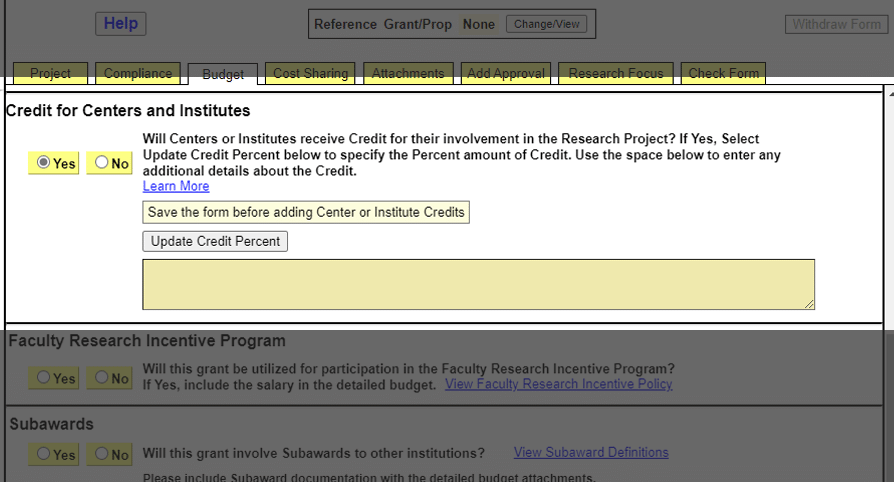Parallel Credit
Parallel credit is a way research teams can acknowledge centers/institutes that contribute to their research efforts. For example, a center /institute might provide PIs/Co-PIs with laboratory space, pre-award support, or post-award project management services.
When filling out the electronic proposal clearance form (ePCF), a PI may assign parallel credit to a center/institute for contribution towards their project. The distribution of parallel credit may be assigned to multiple centers/institutes; importantly, this is a research team decision at the time of submitting the ePCF. Parallel credit is assigned in tandem with credit to the PI's/Co-PI's home organization(s). The VP-RED office uses parallel credit to inform F&A reinvestments for centers/institutes.
No.
When a PI submits a proposal through the ePCF system, they list their home organization so that expenditures are tracked/expensed to the PI's home organization, regardless of whether a center/institute receives parallel credit.
PIs have the opportunity to assign parallel credit to centers/institutes when they submit an electronic Proposal Clearance Form (ePCF).
While credit to a PI's/co-PI's home organization(s) is assigned under the Project tab of the ePCF, parallel credit is assigned under the Budget tab. In the “Credit for Centers and Institutes” section, a PI may assign a percentage to one or more centers/institutes totaling up to 100%.
To assign credit, click the "Yes" button and then the "Update Credit Percent." A list of centers and institutes will appear where you can assign parallel credit.

With input from the research team, PIs may assign any percentage that they feel reflects contributions made by one or more centers/institutes. While the total parallel credit assigned across all centers/institutes may not be greater than 100%, it is possible to assign less than a total of 100%.
PIs may also choose to not assign any credit to a center/institute if none are involved.
Parallel credit is assigned at the proposal stage when a PI completes the ePCF. If the grant is funded, the percentages assigned in the ePCF will be applied to each roll-up index.
Changes to parallel crediting from what was assigned in the ePCF may occur if there is a change in scope of work. Such changes may occur within the same fiscal year but not retroactively to previous fiscal years.
No.
To be sure an academic department gets appropriate credit, PIs need to select their academic department as their home organization in the ePCF.
For multi-PI projects, having details provided in the Multi-PI Budget Template will guide their OSP fiscal manager in creating roll-up index accounts when the proposal is funded. Expenditures will flow through the Banner accounting system to the academic department, and, if the PI assigns parallel credit to a center/institute, their contributions will be in the Research Expenditures Reports.
Yes, if a center/institute is a researcher's home organization and that home organization is where the expenditures will occur, then credit may be given to a different center/institute.
OSP generates Parallel Credit Reports quarterly and provides them to the VP-RED. The VP-RED distributes these reports to respective center/institute directors, deans, and other groups that help inform the annual Facilities and Administrative Costs (F&A) reinvestment strategy (e.g., Research Council).
Centers/institutes that are included in the parallel credit system have VP-RED approval. Initial requests should be made to the Associate Vice President for Research Administration.
The VP-RED considers parallel credit data when creating a reinvestment strategy for Facilities and Administrative Costs (F&As) that MSU recovers from sponsors. The VP-RED also considers input from directors, deans, and other research constituencies (e.g., Research Council) on F&A reinvestment decisions.
A PI's home organization/department is their hiring department (according to Human Resources’ records). This information is pulled directly from Banner into the OSP ePCF system.
Typically, a PI will submit proposals through their home organization so that expenditures can be tracked to their department/college.
However, an otherwise-affiliated PI may choose to have a different organization (i.e., another department or center/institute) administer their grant(s).
OSP establishes a grant index under the administering organization when a proposal is funded, and that organization is responsible for grant management.
